
|
|
|
|
| Für deutsche Version hier klicken |
|
 |
|
|
|
|
» News
|
|

|
|
.: Breakages of anodised Parafly karabiners in the Czech Republic and Brazil: Overload breakages? |
|
May 18th 1980: Peter Ostler flies high banked turns above the landing field after a flight from Wallberg (Southern Germany). Suddenly the pilot is seperated from his glider and falls 100 metres directly at the feet of his horrified fellow pilots. His steel karabiner was broken.
The karabiner showed no signs of deformation in the area around the point of breakage. At that time it was said: "Presumably he previously used the karabiner to tow off his car".
Regarding the case in the Czech Republic, one can read in the magazine DHV Info from December 2004: "The Czech examinations came to the conclusion that the cause was an overload breakage", or in the more recent Brazilian case: "Both karabiners have obvious marks from usage, indicating incorrect application", "Duration of use and course of breakage are not revisable without doubt".

Were it breakages as a result of static overload (so "overload breakages"), or breakages due to dynamic overload (so "material fatigue")?
Due to still unpublished oscillation tests, the DHV has been aware since May 2004 that not only karabiners of the model Parafly Alu are insufficiently fatigue endurable, but also to a similar degree the karabiners from other manufacturers - especially paraglider steel karabiners! Many pilots have meanwhile equipped with supposedly stonger steel karabiners in vain.
|
|
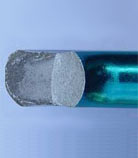
|
|
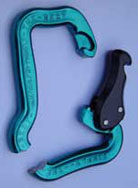
|
|
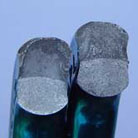
|
|
|
Original images of the karabiner broken in the Czech Republic show a smooth fractured surface with lines of rest.
|
|
|
|
Static overload of a karabiner causes bending deformation. Putting together the pieces of the karabiner that broke in the Czech Republic (shown left), one can discern no measurable bend angle. The anodised layer on the traction side is intact. More than half of the breakage surface shows the clean brittle fracture which is typical for a fatigue breakage. The course of the line of the rest in the middle of the fractured surface is characteristical for an oscillation fracture.

The pictures on the right show an overload breakage with an open catch. Putting together the pieces of this karabiner, one discerns the deformation typical for an overload breakage. The karabiner is bended open in an angle of 15° in the area around the breakage. The blistered anodising layer is clearly visible around the breakage. The breaking load of the karabiner with open catch amounted to more than 700 kg, and to more than 1800 kg with closed catch. The loading that occurs at launch however amounts to approximately 70 kg. A Parafly karabiner has a safety factor of 25 by correct usage, and still a safety factor of 7 when starting with open catch.

How could the karabiner fail anyhow? The answer arises from the breakage pictures and the results of the DHV oscillation tests. These established a fatigue strength of only 30-35 kg. Whilst the static overload causes sizable deformation, the breakages that occured to date during use were almost without deformation as in the oscillation tests. When establishing the static breaking strain, tolerances in the catch play and in the catch joint are insignificant, not however by the determination of the dynamic loading capabilities. In the case of dynamic loading, the karabiner reacts, in the area of the catch play as if the catch was open when catch play is present. In this condition, the tensions in the karabiner material increase by a factor of 25-35. By frequent loading oscillations, a fatigue breakage can occur as shown in the pictures on the left. In this case it is unimportant whether the catch was open or not.

...More on that topic » here!
|
|
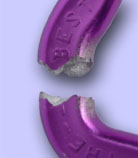
|
|
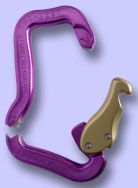
|
|
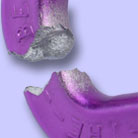
|
|
|
That is what the breakage pattern of a karabiner, that has been loaded with open gate until breakage, looks like.
|
|
|
|
|
Under » http://www.laacr.cz/index.php?Action=View&ARTICLE_ID=427 the Czech engineer Radek Václavik reports on the case.
It is doubtful whether the Czech LAA was aware of the problem with the catch play at the time of the examinations, and that tests for the continous oscillation strength of the karabiner were made.
It is clear from the text of the DHV airworthiness directive from June 2003, that the Czechs merely accertained that the karabiner showed no material or manufacturing faults - which may well be correct. It would be interesting to know how the Czechs would judge the case with current cognizance as regards the dangers of material fatigue.
|
|
| Disclaimer |
|
